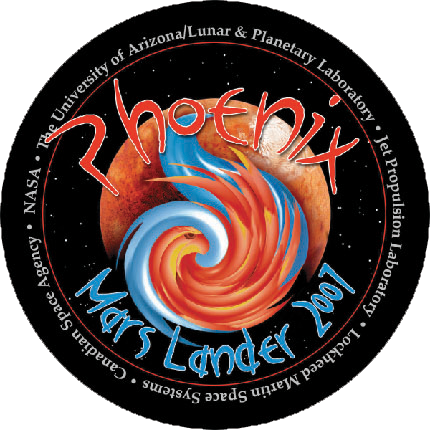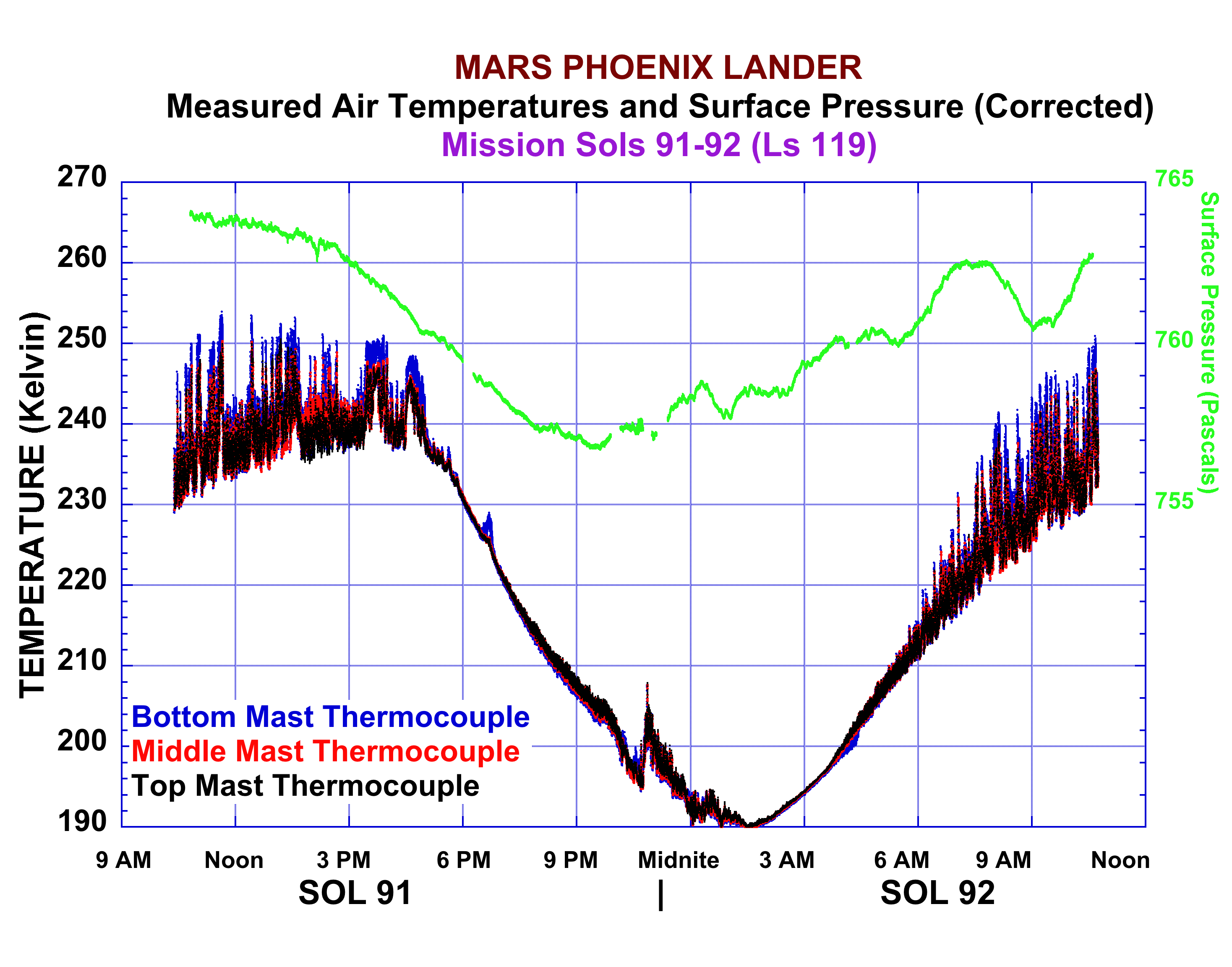
May 26, 2008 (Ls 76.6 MY 29) to Oct 28, 2008 (Ls 148 MY 29)


Above are shown derived near-surface atmospheric temperatures and corrected surface pressure values obtained during ~1 sol of the mission.
This session which began on Sol 91 of the mission was 90110 seconds in duration, starting at 11:25:27 LTST and continuing through to Sol 92, and obtaining measurements at 2 second intervals (0.5 Hz). Most Mars Phoenix Data collection sessions employed this same sequence, spanning slightly more than one sol.
The MET Instrument Package included three thermocouples attached near the Top, the Middle, and the Bottom of the MET Mast (the Telltale wind speed and direction mechanical device was located atop this Mast). The MET Package also included a Pressure Sensor. The Reduced Data file containing the data graphed above is available here.
This session which began on Sol 91 of the mission was 90110 seconds in duration, starting at 11:25:27 LTST and continuing through to Sol 92, and obtaining measurements at 2 second intervals (0.5 Hz). Most Mars Phoenix Data collection sessions employed this same sequence, spanning slightly more than one sol.
The MET Instrument Package included three thermocouples attached near the Top, the Middle, and the Bottom of the MET Mast (the Telltale wind speed and direction mechanical device was located atop this Mast). The MET Package also included a Pressure Sensor. The Reduced Data file containing the data graphed above is available here.
Meteorological Station (MET)
Throughout the course of Phoenix surface operations, MET recorded the daily weather of the martian northern plains using temperature and pressure sensors. It was designed in Canada by Optech and MDA, supported by the Canadian Space Agency. A team headed by York University oversaw the science operations of the station. The York University team includes contributions from the University of Alberta, University of Aarhus (Denmark), Dalhousie University, Finnish Meteorological Institute, Optech, and the Geological Survey of Canada. Canadarm maker MacDonald Dettwiler and Associates (MDA) of Richmond, B.C. built the MET.
Useful Mission Documents
Mission Description
Spacecraft Description>
Software Interface Specification (SIS) - Description of the instrument and data structures
Calibration Document - Description of the calibration methods
Spacecraft Description>
Software Interface Specification (SIS) - Description of the instrument and data structures
Calibration Document - Description of the calibration methods
Archive Bundle Collections
Document - Directory containing the Document Collection, including references to refereed journals using this instrument.
Raw Data - Directory containing the EDR data files for sols 1-150.
Data Set Description (pdf)
Reduced Data - Directory containing the RDR data files for sols 1-150.
Data Set Description (pdf)
For the Experienced User
Complete Bundle - Zip file containing the entire MET Bundle.
MET Bundle Root - The root directory for the MET instrument Bundle for experienced users including links to the context products.
Raw Data - Directory containing the EDR data files for sols 1-150.
Data Set Description (pdf)
Reduced Data - Directory containing the RDR data files for sols 1-150.
Data Set Description (pdf)
For the Experienced User
Complete Bundle - Zip file containing the entire MET Bundle.
MET Bundle Root - The root directory for the MET instrument Bundle for experienced users including links to the context products.
The following approach can be used to obtain data that meets your specifications. Access to a time ordered list of the products allows you to understand the scope of the data set and to assure that you have received all the data that meets your requirements.
Selecting Data - This will allow you to access a time-ordered list of observations and to select products based on physical parameters of your choice. Completion of your product list results in an order returned below.
Receiving Data
Citing Data Sets for Publications
CITATION_DESC = Dickinson, C.D., PHX METEOROLOGICAL DATA V1.0, NASA Planetary Data System, 2008.
Other Useful Products for Interpreting the Data
References - Representative Publications using the data
Other Potential Relevant Data - Data that may be relevant from missions other than PHX
Archived PHX SPICE ancillary data providing observation geometry (positions, orientations, instrument pointing, time conversions, etc.) are available from the PDS NAIF Node.
 PDS: The Planetary Atmospheres Node
PDS: The Planetary Atmospheres Node
